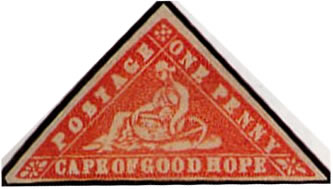From approximately 1883, three postmarks (PS 4 to 6) sometimes called Argus Wheels, were in use on circulars as well as newspapers of the Cape of Good Hope. Another postmark (PS 7) is, in the main, seen stamped on wrappers.

The two values were printed in the required two values of one and four pence. The two values were printed essentially in shades of two colours, red and blue.
| SG No. | Value | Colour |
| 1 | One penny | Vermillion |
| 2 | One penny | brick Red |
| 3 | One penny | Carmine |
| 4 | Four Penny | Pale Milky Blue |
| 5 | Four Penny | Milky Blue |
| 6 | Four Penny | Blue |
| 7 | One penny | Error of colour |
| 8 | Four penny | Error of colour |
Approximately 1883, three postmarks (PS 4 to 6) sometimes called Argus Wheels, were in use on circulars as well as newspapers of the Cape of Good Hope. Another postmark (PS 7) is, in the main, seen stamped on wrappers and circulars, but its use has also been noted on envelopes. The circle measures 27 mm and the upper numerals represent the day and the lower the month. Letters appear on either side of the postmark, but whether these have any significance beyond identifying the handstamp has not been established The roller cancelers (HRD 1 and 2) were intended to deface stamps on newspapers at Grahamstown and were used for this purpose until 1864 or ’65, when they were replaced by the Barred Oval Numeral Cancelers.

From approximately 1883, three postmarks (PS 4 to 6) sometimes called Argus Wheels, were in use on circulars as well as newspapers of the Cape of Good Hope. Another postmark (PS 7) is, in the main, seen stamped on wrappers. From approximately 1883, three postmarks (PS 4 to 6) sometimes called Argus Wheels, were in use on circulars as well as newspapers of the Cape of Good Hope. Another postmark (PS 7) is, in the main, seen stamped on wrappers.


One Penny Error of Colour
Stamps printed with the one penny plates, but using the four penny blue colour exist. This is one of the most sought errors in philately and they can be considered as the jewels of any Cape of Good Hope philatelic collections.

The Four Pence Woodblock Stamps
From approximately 1883, three postmarks (PS 4 to 6) sometimes called Argus Wheels, were in use on circulars as well as newspapers of the Cape of Good Hope. Another postmark (PS 7) is, in the main, seen stamped on wrappers and circulars, but its use has also been noted on envelopes. The circle measures 27 mm and the upper numerals represent the day and the lower the month. Letters appear on either side of the postmark, but whether these have any significance beyond identifying the handstamp has not been established The roller cancellers (HRD 1 and 2) were intended to deface stamps on newspapers at Grahamstown and were used for this purpose until 1864 or ’65, when they were replaced by the Barred Oval Numeral Cancellers, generally used for defacement purposes. The larger post offices were furnished with the cheap rate matter strikes described above. When the Newspaper Branch Office was established at the G.P.O., Cape Town, it was issued with a special datestamp. This, and future handstamps of its type (NP 1 to 5), incorporated the Letters N.P.B. for Newspaper Branch in their design. NP 1, the earliest handstamp in use, is a box with clipped comers. line. A special handstamp (NP 2) was used when the contents came adrift from the newspaper wrapper. It was struck on the wrapper and contained the information “Posted in N.P.B. without contents”. The first recorded use of NP 1 and 2 appears to be October 1877.

The roller cancellers (HRD 1 and 2) were intended to deface stamps on newspapers at Grahamstown and were used for this purpose until 1864 or ’65, when they were replaced by the Barred Oval Numeral Cancellers, generally used for defacement purposes. The larger post offices were furnished with the cheap rate matter strikes described above. When the Newspaper Branch Office was established at the G.P.O., Cape Town, it was issued with a special datestamp. This, and future handstamps of its type (NP 1 to 5), incorporated the Letters N.P.B. for Newspaper Branch in their design. NP 1, the earliest handstamp in use, is a box with clipped comers. line. A special handstamp (NP 2).

The roller cancellers (HRD 1 and 2) were intended to deface stamps on newspapers at Grahamstown and were used for this purpose until 1864 or ’65, when they were replaced by the Barred Oval Numeral Cancellers, generally used for defacement purposes. The larger post offices were furnished with the cheap rate matter strikes described above. When the Newspaper Branch Office was established at the G.P.O., Cape Town, it was issued with a special datestamp. This, and future handstamps of its type (NP 1 to 5), incorporated the Letters N.P.B. for Newspaper Branch in their design. NP 1, the earliest handstamp in use, is a box with clipped comers. line. A special handstamp (NP 2).
Four Penny Error of Colour
Stamps printed with the one penny colour, but using the four penny blue plate exist. This is one of the most sought errors in philately and they can be considered as the jewels of any Cape of Good Hope philatelic collections.

These errors are exceedingly rare and expect to pay anything from £10 000 to £20000. These should not be bought without a certificate and without determining their provenance. These errors were part of all the famous collections such as the Maxwell, Ferrari, Lichtenstein and others and when they do come up for sale inevitably they can be traced back to one of these collections.



